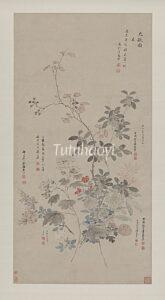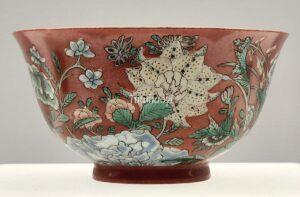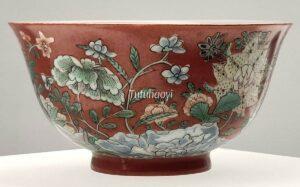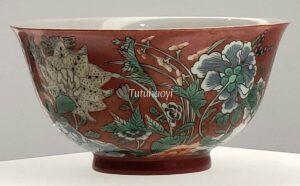Nine Autumn Flowers
九秋图
© Tutuhaoyi.com owns the copyright of the description content for the images attached. Quoting all or part of the description content on this page is permitted ONLY IF ‘Tutuhaoyi.com’ is clearly acknowledged anywhere your quote is produced unless stated otherwise. (本页描述内容版权归Tutuhaoyi.com所有,转发或引用需注明 “Tutuhaoyi.com”, 侵权必究, 已注开源信息的条目除外。)
The ‘Nine Autumn Flowers’ (Jiu Qiu Tu 九秋图) is a distinguished pattern in traditional Chinese decorative art, frequently employed to symbolise the richness and splendour of the autumn season. This theme features nine varieties of flowers, although not in a fixed set, collectively representing abundance, vitality, and the vibrancy of the autumn. While the specific floral elements may vary by artwork, the following are commonly depicted:
- Chrysanthemum (Ju Hua 菊花): Emblematic of purity and longevity, it is a quintessential symbol of autumn.
- Osmanthus (Gui Hua 桂花): Associated with wealth, auspiciousness, and harvest, its fragrant blooms enhance its symbolic appeal.
- Cotton Rose (Furong 芙蓉): A representation of beauty and prosperity.
- Hibiscus (Mujin 木槿): A metaphor for gentleness and resilience.
- Pomegranate Flower (Shiliu Hua 石榴花): A symbol of fertility, prosperity, and vitality.
- Begonia (Qiuhaitang 秋海棠): Conveying happiness and harmonious relationships.
- Chinese Rose (Yueji 月季): An emblem of flourishing prosperity and success.
- Morning Glory (Qianniu Hua, 牵牛花): Representing vitality and new opportunities, often associated with the changing seasons.
- Cockscomb (Jiguan Hua, 鸡冠花): Representing good fortune and vibrant energy.
- Golden Lotus (Jinlian Hua, 金莲花): A sacred flower associated with spirituality and beauty.
- Silvergrass (Yinliang Cao, 银亮草): Often used in autumn scenes to add texture and an ethereal quality to the composition.
Related Pun Pictures:
May you have as many male offspring as a pomegranate has seeds 榴开百子
May you have repeated promotions 官上加官
May your jade palatial home be honoured and full of riches 玉堂富贵
Fig 1: Nine Autumn Flowers 九秋图, hanging scroll, ink and colour on paper, by Wang Hui (王翚 1632–1717) and eight other painters, 1695, courtesy of the Palace Museum, Beijing
Fig 2: Nine Autumn Flowers 九秋图, handscroll, ink and colour on paper, by Qian Weicheng (钱维城 1720–1772), 1767, courtesy of the China Three Gorges Museum, Chongqing, China
Fig 3: Nine Autumn Flowers 九秋图, handscroll, ink and colour on paper, by Qian Weicheng (钱维城 1720–1772), 1768, courtesy of the Palace Museum, Beijing
Fig 4-6: porcelain bowl with overglaze enamelled decoration, Kangxi period (1662–1722), Qing dynasty, courtesy of the Shanghai Museum, China, photography by Rachel Ma





